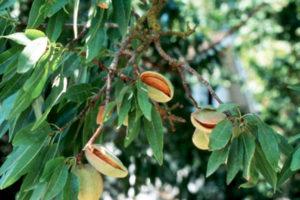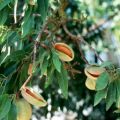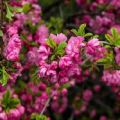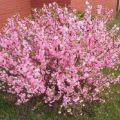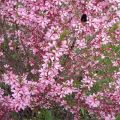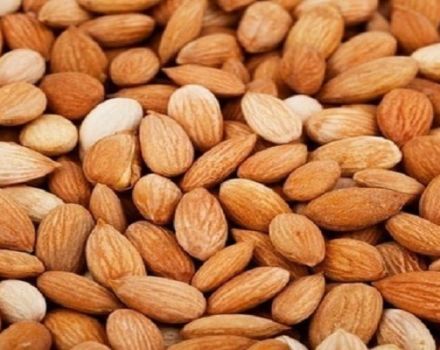Description of the best varieties of almonds, cultivation, care and propagation methods
Growing almonds requires careful care of the crop and the implementation of certain agricultural techniques. The plant forms a fruit with a bone, which is rich in useful trace elements. It is important to choose the right variety suitable for the region's climate and soil composition. Care involves adherence to the irrigation regime, fertilization, crown pruning and other nuances. There are several options for breeding shrubs.
Content
- 1 General description and characteristics of the culture
- 2 Almond varieties
- 3 The subtleties of growing a plant
- 4 Nuances of wood care
- 5 Treatment against diseases and pests
- 6 Almond propagation
- 7 Features of cultivation in different regions of Russia
- 8 Harvesting and storage of crops
- 9 The use of a flowering tree in landscape design
General description and characteristics of the culture
Almonds are a plant that produces hard stone fruits. The shrub tolerates drought and low temperatures well. Flowering occurs in February-April and lasts up to three weeks. The inflorescence is formed of five large petals of a crimson hue. Nuts appear in early summer.
The almond bush is capable of developing over a century. Fruits begin to form in the 5-6th year. The almond fruit is a small stone covered with a green-gray rounded pericarp with villi.
Almond varieties
Before choosing a variety, it is necessary to determine the purpose for which it is supposed to grow. More than 38 types of almonds are known. Some varieties are suitable for plot decoration. Fruits of ornamental varieties are not eaten.
Common almonds
The spreading bush stretches up to 4.6 meters. Flowering begins early - in the first decade of March. Long branches of the bush are covered with pale pink inflorescences. The fruits ripen in the last days of July.
There is a bitter (wild) and sweet type of common almond. The first type of almond is intended for medical use. For eating, it is recommended to plant a sweet look.

Low almonds, either steppe or bean
The shrub is a deciduous plant. Its height does not exceed 155 cm. The spherical crown is lush and dense. The bark is distinguished by a red-gray color. The oblong-elongated leaves have a fleshy structure.
The flowering of the legume is beautiful, lush, but not long. Almonds begin to bloom in the last days of March.A shaggy drupe with a bone strews the tree at the end of summer days.
Georgian almonds
The Georgian almond variety grows in the Caucasus. The shrub is no more than one meter in height. There are few branches, the leaves are large, elongated. It begins to bloom in early May. The branches are covered with white-pink inflorescences.
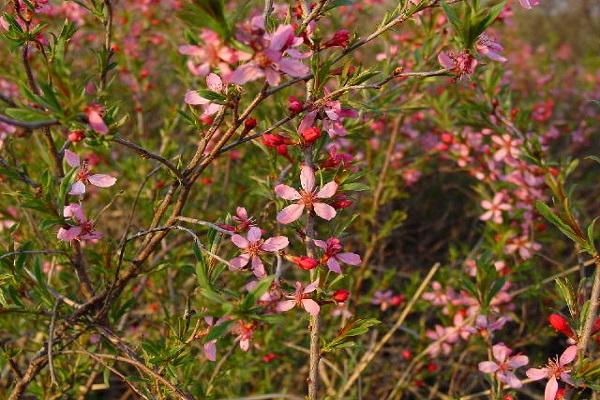
Ledebour almond
This variety of almonds is found in the vastness of Altai. Small shrub with spreading branches. Height does not exceed 125 cm. Loves light and tolerates frost. Flowering begins in early May before the leaves begin to bloom. The inflorescence petals are deep pink. Flowering lasts up to three weeks.
Almond Petunnikov
The birthplace of Petunnikov's almonds is Central Asia. The variety is characterized by low growth. The crown is spherical, the branches are straight. The leaves are oblong with rounded teeth at the edges. Flowering begins in mid-May and lasts two weeks. Fruits are formed in the 6th year after planting.
Three-lobed almond
China is considered the birthplace of the three-lobed almond. The tree grows up to three meters. The flowering period begins in mid-May and lasts two weeks. Then the leaves begin to bloom, which have a three-lobed shape.
This type of almond also has other names: Trilob, Aflatunia, Luiseania. The following varieties are considered prominent representatives of this group of almonds: Vesnyanka, Ruslana, Kievskaya, Plena, Snega Uimura.

The subtleties of growing a plant
There are many peculiarities and nuances of how to grow almonds. Culture needs the right choice and preparation of the place. It is also important to take into account that for pollination it is required to plant other varieties nearby and attract pollinating insects to the site.
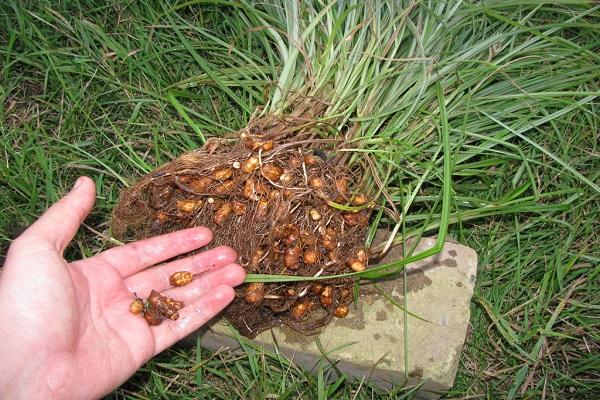
What time to plant
It is preferable to plant a crop in the country in the middle of autumn, after all the leaves have fallen off. When planted in spring, the tree takes root worse. You should wait until the threat of frost has finally passed.
Almonds are planted in the morning or in the evening, a couple of hours before sunset.
Location
To obtain a high-quality harvest, a number of conditions must be met:
- For landing, choose the warmest and lightest place on the site, protected from through winds.
- The minimum distance to other fruit trees is 160 cm.
- Planting in low-lying areas should be avoided.
- On the site, groundwater should not pass too close. If they flow at a depth of 155 cm and closer, then it is better to choose another site.
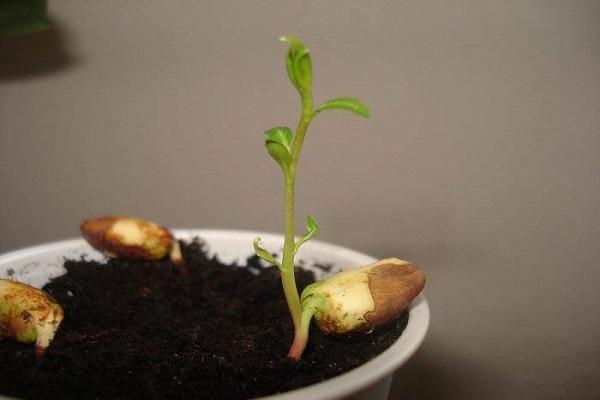
The soil
The tree does not impose special requirements on the composition of the soil, it is capable of developing in sand, on stones and gravel. The best results will be obtained when growing the crop in fertile, light, loose soil, rich in calcium. A sandy loam or loamy composition is well suited.
The roots do not tolerate the presence of closely spaced groundwater, high acidity, chlorine and salt content. The soil must necessarily pass air and water well.
The choice of planting material
When choosing a seedling, you always need to study the characteristics of the variety, it is imperative to check with the seller if the plant is adapted to the weather conditions of the region. You only need to buy seedlings from a trusted seller:
- The trunk should be strong with a glossy bark without cracks or abrasions.
- On the branches, the buds are large, without damage.
- There should be no dry shoots and growths on the roots.
- Dark areas on foliage or bark indicate a hypothermia of the culture.

Planting process
Vegetable growers are interested in the question of how to plant almonds. Seedlings are planted in the area at intervals of 2.5 meters. In order for the procedure to pass without errors, you need to perform a series of sequential actions in the following scheme:
- a hole 52 cm deep is dug in the selected area;
- arrange a drainage layer;
- then a layer of sand is poured;
- make nutritious components;
- plant the tree carefully, straightening the root branches;
- the pit is covered with earth so that the root collar protrudes 13 cm;
- install a support for tying;
- poured abundantly with warm water.
At the last stage, it is recommended to mulch the root zone with peat, straw, sawdust.
Nuances of wood care
Homemade almonds require special attention and care. It is necessary to water the crop correctly and on time, introduce nutrients, weed the soil from weeds and loosen it, treat it from pests and infections, and protect it from frost.
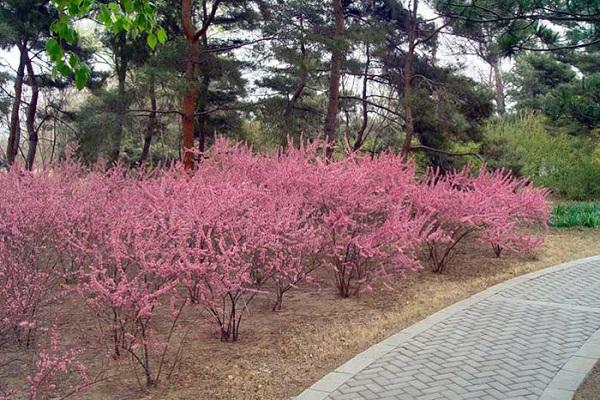
Watering
Moistening the soil should be carried out regularly so that the near-trunk zone never dries out. Stagnation of moisture should not be allowed, otherwise the risk of developing fungal infections and rot will increase.
It is recommended to water the tree every seven days, and up to 9 liters of water should be consumed. Only warm, settled water is used for irrigation of the culture. After each irrigation, it is necessary to loosen the soil to a depth of 7 cm and weed from weeds.
Top dressing and fertilizers
It is recommended to fertilize almonds several times per season:
- In the spring, it is recommended to mulch the near-trunk zone with mullein or manure.
- A month later, the plant is watered with a liquid solution based on ammonium nitrate and urea.
- In the fall, it is desirable to add a composition of double superphosphate and potassium sulfate.
If the soil is soft and fertile, then it is enough to water the tree once a season with a solution based on superphosphate.
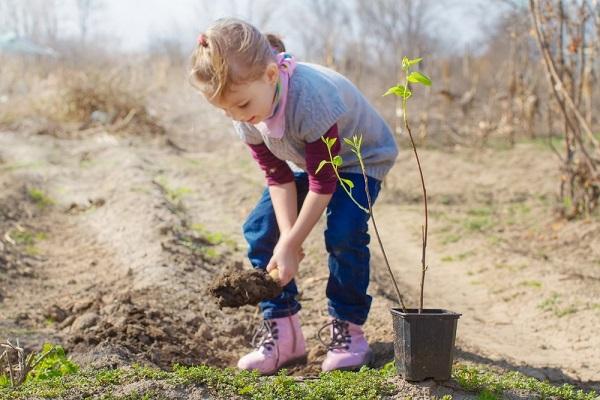
Weed control
Weeding should be constantly carried out around the young seedling. Weeds contribute to the spread of infections and pests. An adult plant is rarely overgrown with weeds, since the dense crown drowns out their growth.
Bloom
Almonds are pleasing to the eye with abundant and elegant flowering. The flowers are large, depending on the selected variety, they can be white-pink, burgundy or crimson. Throughout the flowering period (the period lasts up to three weeks), it is required to moisturize the soil abundantly. Deficiency of moisture will lead to premature end of flowering and reduced yield.
Wintering
The almond bush tolerates frosts down to -15 degrees well. At temperatures below this mark, the tops of young branches can freeze:
- To prevent the plant from freezing, it is recommended to pinch the ends of the shoots at the end of summer.
- Young seedlings in the fall are covered with dried foliage or straw 18 cm from the ground.
After snow falls, a snowdrift is formed around the trunk. The main thing is that the root collar of the tree does not rot, otherwise rotting will begin.
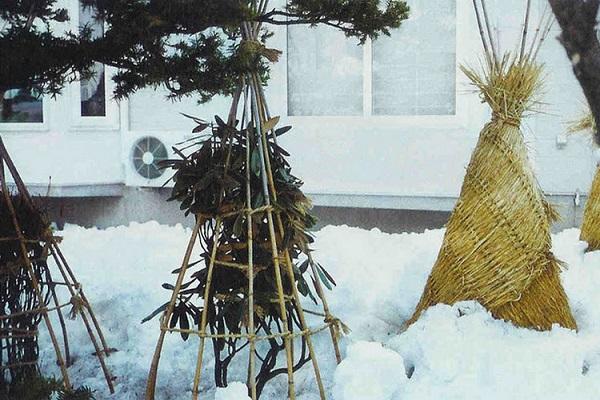
Almond pruning
It will be possible to give a neat shape and rejuvenate the plant by pruning:
- In the spring, before the juices start moving, dry, frostbite and damaged branches are removed. You should also thin out the places where many shoots grow. Leaves strong and sturdy branches.
- After flowering, thin out the area where many branches have grown, leaving the strongest shoot.
- Rejuvenating almond pruning is done after 8 years of crop growth. Old branches are shortened or completely removed.
Treatment against diseases and pests
Diseases can significantly reduce the yield and completely destroy the plant. Moniliosis, scab, rust and clasterosporium are common. In recent years, almond burn has become widespread. The causative agent of the disease is the mushroom Polystigma ochraceum.
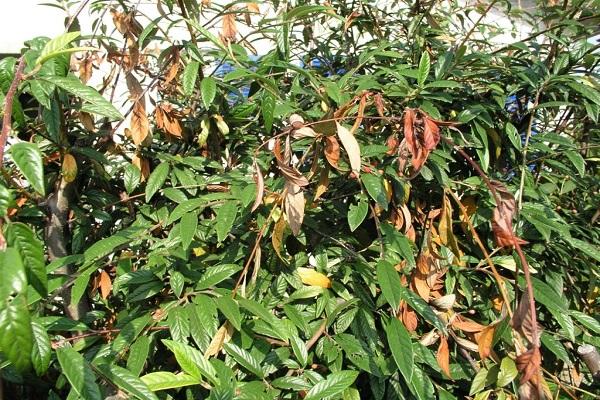
The fight against infections is carried out with biological products, chemicals or compositions from folk recipes. Treatment with drugs such as "Hom", "Baylon", "Zaslon", "Fundazol", "Topaz" is effective.
From insects, aphids, leaf rollers, almond seed-eaters, and spider mites cause harm to the development of a plant. Such drugs as "Actellik", "Fitoverm", "Fufanon", "Vertimek" help to fight the invasion of pests.
In early spring, before the appearance of buds, a preventive treatment of wood and soil is carried out with a solution based on Bordeaux liquid.In October, after all the leaves have fallen off, the treatment is repeated.

Almond propagation
Almonds are propagated by seeds, cuttings, or root division. Each method has its own advantages and some disadvantages.
From bone
Reproduction by bones is possible. When growing a seed culture, you need to be prepared for the fact that the original characteristics of the variety may be lost. Stages of planting a bone:
- large, dense, defect-free specimens are selected;
- soak the bones in growth stimulants and leave to germinate;
- holes are made on the site with an interval of 18 cm and a depth of 12 cm;
- seeds are planted in late autumn;
- a couple of bones are laid in one recess;
- after the sprouts appear, the strongest seedling is left.
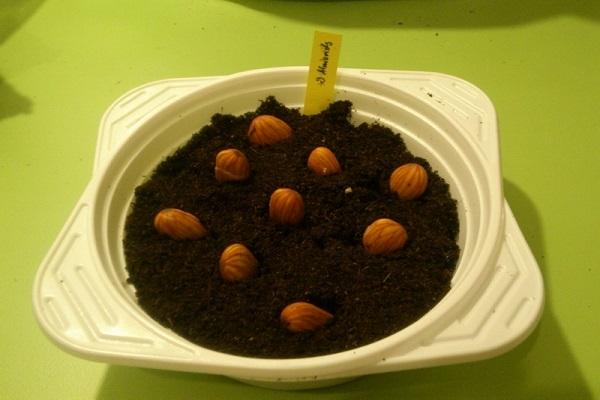
Almond grafting
It is permissible to graft almonds on a tree of the same variety and on other varieties. The vaccination is carried out during the period of active movement of the juice - in early spring or in the last days of summer.
2-3 days before the procedure, the stock is watered abundantly with water. This is done so that the bark separates well from the wood. A straight, healthy stalk with a formed bud is suitable for the scion. All the leaves are plucked from the cutting.
A small incision is made in the area of the root collar of the scion and the bark is pushed back. At the cutting, the scutellum with the kidney is cut so that it fits into the cut made. The stalk is inserted into the incision, fixed with a tight bandage, leaving the kidney outside.
If the procedure is successful, then after 2.5 weeks the peephole turns green and the petiole dries up. After that, the bandage must be loosened. In the spring, as soon as the first leaves appear, the bandage is removed.
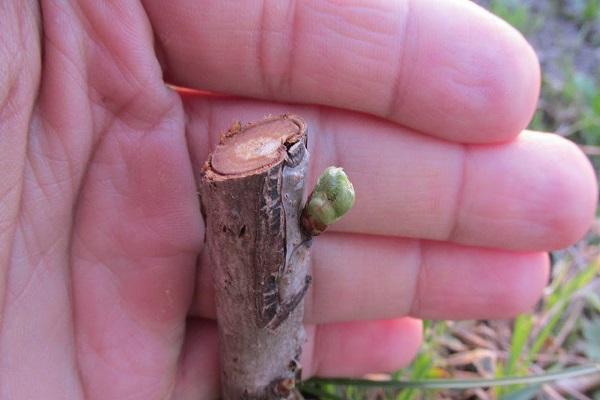
Cuttings
Almonds can be propagated by twigs. Cuttings are carried out in early June. Cuttings with a length of 18 cm are cut from the top of the tree.Each process should have two buds:
- Cut shoots are kept in solutions with growth stimulants.
- Then the cutting is planted in a mixture of peat and sand.
- The seedlings are transferred to a cool place and left for a month.
In the allotted time, the seedlings have time to adapt and take root. After that, they begin to transplant to a suitable piece of land in the garden.
How to propagate by growth
If you cut off the branches of a tree, then it will form numerous shoots. The next year, the appearing processes are cut off along with the root branches and transplanted into a separate area.
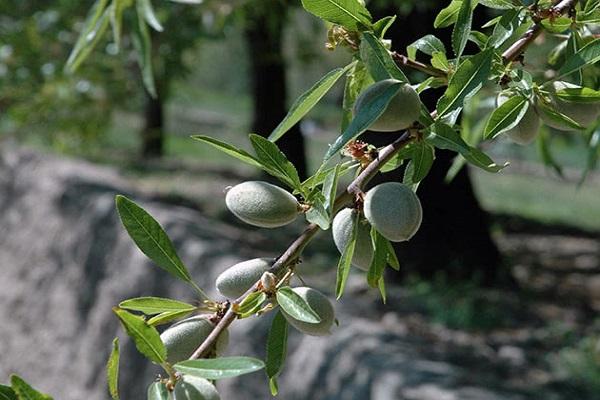
Reproduction by layering
Young shoots of almonds are used for further propagation by layering. The branches are bent to the ground, fixed with staples and covered with a layer of earth. After a year, the cuttings should have roots. All this time, you need to weed and water the soil around this place. The seedlings are then detached from the mature tree and transplanted into a permanent area.
Features of cultivation in different regions of Russia
It is easiest to grow a crop in regions with a warm climate. Even in the southern regions of Russia, the plant may not form fruit. Therefore, you should carefully choose the variety and carefully study the frost resistance.
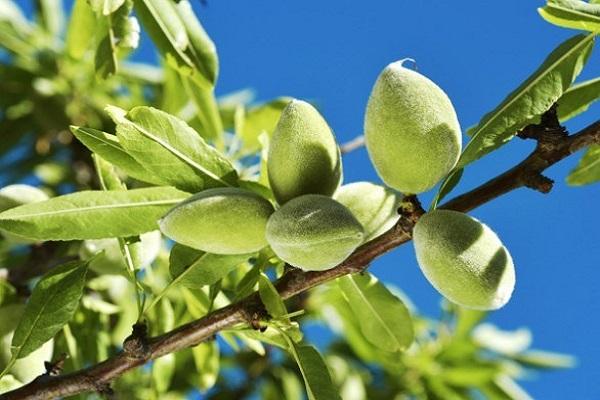
Almonds will simply be grown in the Crimea, Krasnodar Territory, but only where there are no sharp temperature fluctuations. If the cold returns after the flowers bloom, the flowers and ovaries will fall off.
In central Russia, the cultivation of the Dessertniy almond variety shows good results. This variety can withstand frost and flower buds do not fall off.
In the Moscow region, it will be possible to harvest the crop only when growing crops in a greenhouse. An ornamental almond variety can be planted in an open area. Even if you provide proper care and follow all agricultural techniques, it will not be possible to harvest a good harvest in the Moscow region without a greenhouse or high-quality shelter.
In Siberia, steppe almonds are grown in open spaces without shelter for the winter. In the central lane, the three-bladed shrub variety feels good.

Harvesting and storage of crops
When almonds ripen, the oval shell of the fruit begins to crack along the lines, after which it is easily separated. Inside there is a bone up to 30 cm long, oval-elongated or drop-shaped, beige or brownish.
Harvesting of the ripe crop begins in late July. The bones are freed from the pericarp and dried in the sun. If unrefined grains are harvested, they can be stored in cloth bags. Choose a dark and well-ventilated storage place.
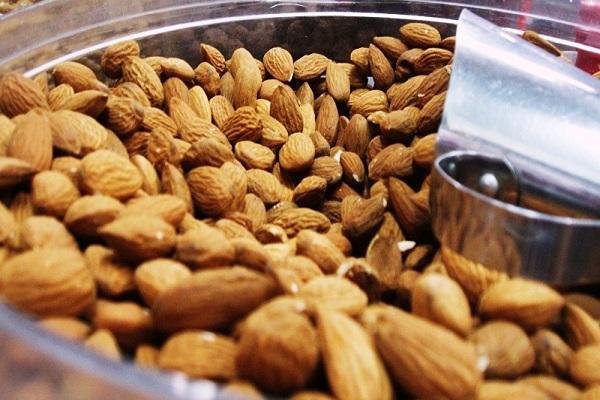
The use of a flowering tree in landscape design
Almonds have an unforgettable flowering, so the tree is often planted for decorative purposes. To make the plant decorate the site, you can use the following tips:
- shrubs are planted along the alley;
- make an arch for rest;
- almonds look beautiful in combination with other large-leaved crops;
- shrubs look beautiful on a flat green lawn;
- will decorate a rocky garden;
- hedges are made from trees.
Planting almonds is easy. Leaving does not require too much time and effort. Blooming will beautify any area, and the fruits will bring health benefits.

